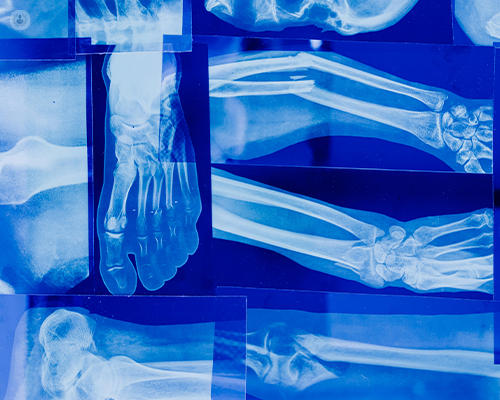Picking a bone with osteoporosis: diagnosis and treatment
Escrito por:Osteoporosis is a weakening of the bones that is common in older women, but in truth can occur in anyone regardless of sex or age. In this article a leading rheumatologist explains this condition, how is it diagnosed, and how it can be treated.

What causes osteoporosis?
Bone, just like the rest of the bodily components, is constantly being broken down and replaced. Osteoporosis occurs when the body halts bone production, a job which also includes the upkeep and fortification of existing bones. When this happens, the bones structurally weaken and lose mass, thus making them brittle and prone to breakage. Bones are sort of like coral – they may look solid and static, but they are living, porous, growing, and changing over time.
Osteoporosis develops over several years but is typically only first noticed when there is a bone fracture from an injury or accident. The most common fractures in people with osteoporosis are in the wrist, hip, and vertebrae. Other signs that are more subtle are changes in the physical shape, such as losing some height or a curving posture, which are indicative of the spinal bones collapsing under the pressure of the body’s weight.
Those experiencing or who have experienced menopause are very susceptible to osteoporosis due to the loss of oestrogen, as oestrogen is used to facilitate the structure and maturation of the bones. Other risk factors include:
- taking high-dose steroid tablets for more than 3 months
- a family history of osteoporosis
- long-term use of certain medicines that can affect bone strength or hormone levels, such as anti-oestrogen tablets that many women take after breast cancer
- having or having had an eating disorder such as anorexia or bulimia
- not exercising regularly
- heavy drinking and smoking
How is osteoporosis diagnosed?
Osteoporosis can be diagnosed with bone density testing, most commonly using a dual-energy X-ray absorptiometry (DEXA) scan, which tests bone mineral density. The scan procedure involves the patient lying on their back on an X-ray machine, and an arm suspended above them takes the scan. It is a quick scan, around 15 minutes, and is painless for the patient. The results are rated against those of a healthy person with consideration to the norms of age, sex, and ethnicity. The difference is calculated as a standard deviation (SD) and is called a T score.
How is osteoporosis treated?
Osteoporosis cannot be cured, as the rate of bone formation can never be augmented to overtake the rate of bone loss, but it can be managed and the loss of bone density is slowed whilst the existing bone tissue is strengthened.
Common methods of management include:
- More exercise, especially involving weights, to strengthen muscles and balance. This can be weightlifting, but also walking, swimming, Pilates, yoga, tai chi, and dancing.
- Vitamin and mineral infusion, specifically vitamin D and calcium. This can be in the form of dietary adjustments, or supplements. For more vitamin D, spend more time in the sun (with protection!).
- Reduction of substance usage, like tobacco and alcohol.
- Medication therapies, such as bisphosphonates, which slow down the rate of bone degradation and can be administered as a tablet, a fluid, or intravenously; hormone-replacement therapy with synthetic oestrogen, which helps emulate the role of oestrogen in bone maintenance and is often prescribed for women after menopause; and for extreme cases of osteoporosis, parathyroid hormone can be injected monthly to increase bone density – but it can cause side effects like nausea and headaches.
If you believe you may be struggling with osteoporosis, consult with a specialist about diagnosis today via Top Doctors.


